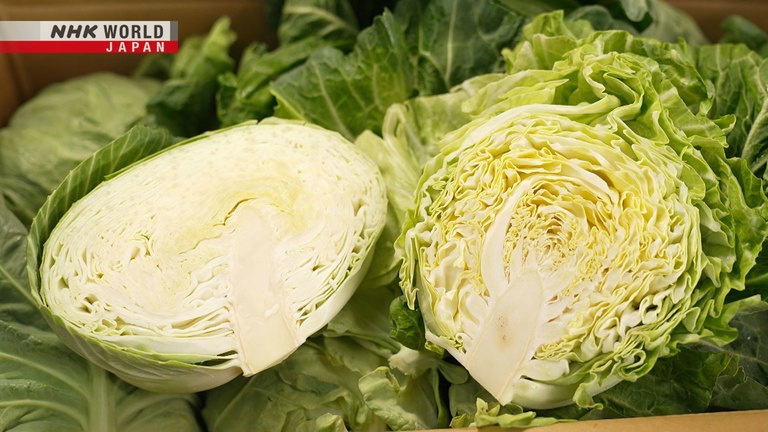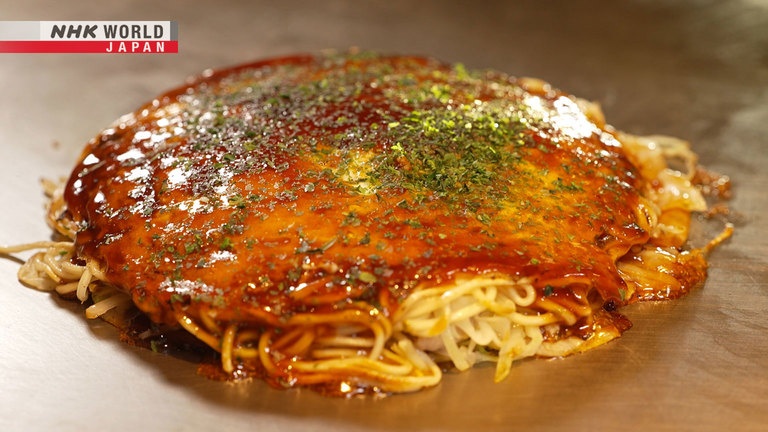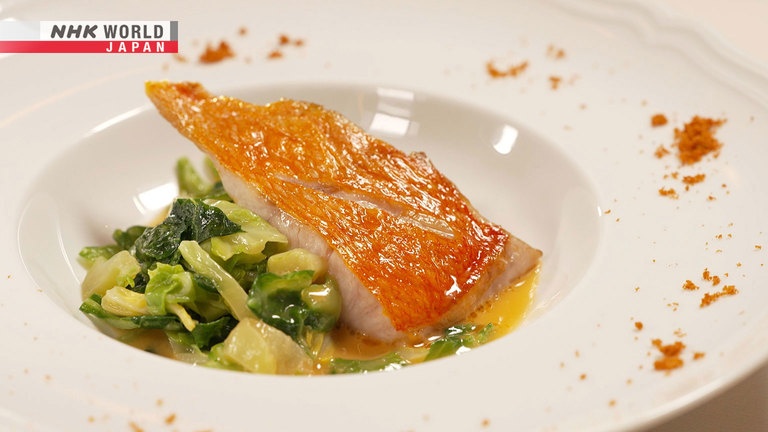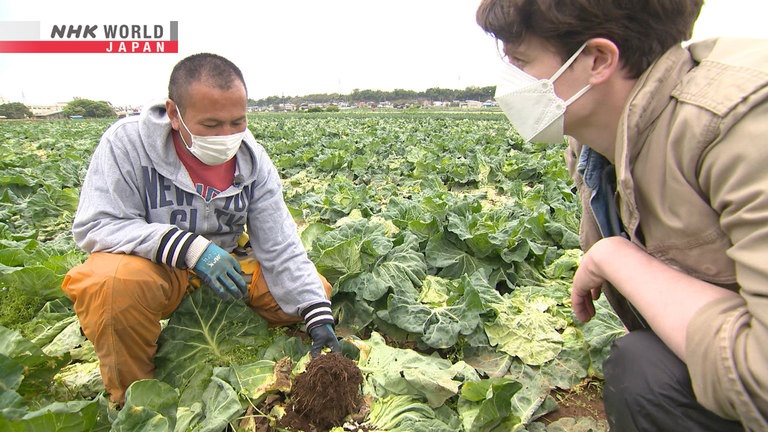CABBAGE
Affordable and voluminous, cabbage is the star of the Japanese dinner table. The all-purpose veggie is great raw or cooked, and you can't have deep-fried pork cutlets in Japan without a mountain of the stuff. Spring cabbage is particularly loved for its soft leaves. Try sushi with sweet, fresh cabbage at a local producer, and see how once discarded cabbages are used in sustainable aquaculture. Also try tasty Italian meals featuring the versatile veggie. (Reporter: Kyle Card)




Transcript
Tokyo: this world-class metropolis is a veritable gourmet wonderland.
Discover the stories behind the ingredients that make this city so delicious - so "oishii."
The theme today is cabbage, a vegetable that's familiar all over the world.
Being both dense and affordable, it's a top-selling veggie in Japan.
You can cook it, or eat it raw - there are many ways to enjoy this versatile ingredient.
In Japan, you can't have deep-fried pork cutlets without loads of shredded cabbage.
Great!
It's sweet!
Excellent!
Why is Japan so crazy about it?
Dig in to discover the multilayered world of cabbage!
Trails to Oishii Tokyo.
Hello there.
My name is Kyle Card and I'm an actor from Canada.
And today we're going to explore the world of cabbage.
In my experience back home, cabbage isn't exactly a major player on the dinner table, so I was very surprised to come to Japan and see it almost literally everywhere
and eat it in just as many different ways.
To this day I do not understand why it is so popular here, so why don't we go on a journey and find out together?
Kyle visits Shinbashi, a major business district in Tokyo.
There's a restaurant here that serves a uniquely Japanese dish with cabbage as the main ingredient.
It's called "okonomiyaki" - it's basically a Japanese pancake.
The comfort food is loved by all ages.
Hiroshima-style okonomiyaki is famously made with a ton of cabbage.
It's a specialty at this restaurant.
- Hello.
- Welcome.
With 36 years of experience, Kamikawa Manabu is an expert okonomiyaki chef.
- That's a lot of cabbage.
- It is.
How much do you use every day?
About 6 heads per case this season,
and we go through 5 or 6 cases.
Ten cases on a busy day.
That much?
Hiroshima-style okonomiyaki
is mostly cabbage.
Hiroshima-style okonomiyaki is characterized by layers of ingredients.
You're piling it on.
A mountain of shredded cabbage goes on a bed of cooked batter.
One okonomiyaki calls for 170 grams.
On top of that goes bean sprouts and pork belly, and then it's flipped over.
The batter acts as a lid.
Steam collects in the middle.
There's more to it than grilling.
More like steaming.
Steamed cabbage.
There you have it - Hiroshima-style okonomiyaki is more of a steamed recipe.
Once the cabbage is partly clear, and the sweetness has come out...
...add a layer of Chinese noodles.
And an egg!
Nice and thick!
Beautiful!
Looks so good.
To finish it off, lather it with sauce and sprinkle on some dried seaweed.
Eat it with the small spatula.
That's the Hiroshima way.
- With this? Just dig in?
- Yeah.
So easy to cut.
It's hot.
Look at that.
Hot and steamy.
Excellent.
The cabbage is so sweet.
- It's pretty sweet.
- Right.
It has a fun texture.
It's like al dente pasta. It's good
with a slightly crunchy texture.
Al dente applies to cabbage too?
Sure. It's soggy and not as good
when cooked for too long.
It needs a good, balanced texture
so you can enjoy every bite.
I could eat this every day.
It's all about fresh, sweet cabbage.
I'm coming here every day.
Kyle heads to Tokyo's Ota Market to learn more about Japanese cabbage.
Receiving the largest amount of produce in Japan, the market boasts the highest trading volume of cabbage.
300,000 cabbages come in each day.
- Hello!
- Hello.
Narita Yukihiro has worked in cabbage sales at a wholesale company for 18 years.
This is standard Japanese cabbage.
It's known as "winter cabbage" because, you guessed it, winter is the peak season.
How do you spot delicious cabbage?
For this type, ones with slightly dark leaves.
A white base.
And they should have some weight to them.
That means they're fresh and tasty.
A cross-section reveals more.
No space in there.
Well, over here there is, but it's quite squished together.
Nice and tight and dense.
Pretty heavy with a dense core.
Very nice.
The cut end being white is a sign of freshness.
It'll get darker as time passes.
How much for one?
It depends on the daily market value,
but roughly 1 or 2 dollars.
Easy on the wallet.
And you get a lot.
I guess people like that you can
use one to make a whole meal.
Its low price and year-round availability make it a popular grocery item.
Although a key part of the Japanese diet, cabbage was initially brought from Europe.
It was introduced in the early 18th century, and cultivated primarily as an ornamental plant.
In the mid-19th century, cultivation for consumption was started to appeal to expats.
Over the years, breeding took place to better suit the Japanese climate, and improve quality.
One type has become especially popular.
These look very different.
Kind of fluffy.
- This is spring cabbage.
- Spring cabbage.
Spring cabbage is only available in spring, from March to May.
It's a very popular spring ingredient.
You could say it's the flavor of spring.
What does its cross section reveal?
It's like lettuce.
These have a lot of moisture
and a soft texture.
It looks pretty soft.
Here's the one from before.
Totally different.
That one is very dense.
Right.
When side by side, it's like night and day.
Where is spring cabbage harvested mainly?
They have to be grown in a warm
climate with strong sunlight.
Ones from Kanagawa's Miura Peninsula
are in season right now.
Got it.
- Off to Miura I go.
- Great.
Wasting no time, Kyle heads to Miura Peninsula where spring cabbage is grown.
Miura City in Kanagawa is a one-and-a-half-hour drive from Tokyo.
The peninsula's mild winters and minerals from the ocean breeze create the perfect environment for tasty, sweet cabbage.
Miura is a major producer, shipping around 50,000 tons from winter to spring.
Cabbage to the left and to the right.
Mind boggling.
Kyle heads to a field that's been around since the Edo period.
- Hi!
- Hello.
This is 30-year cabbage farmer, Kato Masaki.
Which are ready for harvest?
Most of them are pretty much ready.
Like this one. If you touch it,
it feels nice and firm.
- May I?
- Sure.
It's hard.
It is quite firm.
So, from experience you can tell just by looking?
I can tell, yeah.
This weighs around 1,300 grams.
The outer leaves protect the cabbages during transport.
Just a quick cut.
That's it.
Cool. They seem pretty easy to harvest.
I guess it may look that way, yeah.
Kyle gives it a try.
Got it!
What are you doing?
You hit the ground with the knife,
so there's dirt on the cut.
I see. Sorry about that.
That means that this little cabbage will not be going to market.
Harvest season is from mid-March to early May.
Cabbage grows faster as the weather gets warmer, so if they're left out for too long, they'll start to crack.
That means timing is crucial.
When harvested before they begin to crack, the cabbages are nice and sweet.
The center section is the sweetest and most tender.
Kyle takes a quick bite.
It's pretty sweet, actually.
I can't stop.
I can just keep eating it.
It's like a bag of chips. Just going at it.
Soil preparation is a key factor here.
Any special way of prepping the soil?
I use bamboo powder.
- Bamboo?
- Yes.
- Powdered?
- Yeah, bamboo.
Minerals in bamboo stimulate microorganisms in the soil, increasing nutrients that help the cabbage grow sweeter.
This led Kato to the city's unattended bamboo groves.
If left alone, bamboo will quickly spread into neighboring fields and forests, blocking sunlight and causing other plants to die.
Their shallow roots could even trigger a landslide.
Kato maintains bamboo groves as a volunteer and uses what he cuts away.
Using powdered bamboo helps
maintain dense groves.
And it also makes the cabbage
sweeter and tastier.
The customers love them too,
so it's like a win-win-win situation.
Kato's wife, Yoko, shows Kyle a way to enjoy tender spring cabbage to the fullest.
First, gently rub salt on the leaves.
Let them sit for three hours as the salt takes in moisture.
This is what you'll get.
It seems elastic.
Firmer than before.
I know what you mean.
Tightly held together.
Mix vinegared rice with salmon flakes, scrambled egg,
and salted cucumber.
Wrap the mix in a salted cabbage leaf.
It's sushi rolls...
with spring cabbage!
Here I go. "Itadakimasu."
"Oishii."
It's sweet.
It's elastic, but still has a crunchy texture.
Cabbage can replace nori seaweed!
Nori can get quite sticky, but
cabbage maintains a crunchy texture.
Do you like this too?
Yeah. I would put sesame oil on it.
Thank you.
This is great!
Perfect.
Great!
Miura's climate and the powers of farmers combine to make sweet and tasty cabbage.
In Miura, cabbage has come to play a very important role.
Kyle visits a research facility that supports the Kanagawa fisheries industry.
The staff develop processing and aquaculture technology, and conduct research on marine ecosystems.
We've done something innovative with cabbage.
Something new?
Shall we take a look?
Absolutely.
Sea urchins!
It's murasaki uni, a common type
of sea urchin in Japan.
Are those cabbage leaves?
Exactly.
What for?
They eat the leaves.
They're called cabbage sea urchins.
Cabbage is helping to fix a major problem in the oceans.
As seaweed disappears, beds become barren, looking almost like a burnt field.
Global warming has increased water temperatures, and the number of organisms that feed on seaweed.
Hungry for food, sea urchins eat all the way down to the buds, making it hard for seaweed to grow back.
On top of this, fishers are left with an unhealthy catch that can't be sold.
This method was started in the hope of improving the quality and marketability of the sea urchins.
Being omnivores, the sea urchins were given 300 types of produce, and seemed to prefer cabbage.
Usui then began acquiring sub-standard cabbages from local farms.
Small or damaged ones like these are often thrown out otherwise.
The sea urchins are happy,
and so are cabbage farmers.
The outer leaves are especially important.
Sea urchin roe is supposed to be yellow.
When sickly like this, it's dark brown.
I see.
In particular, eating dark
leaves improves their color.
Just like how plants improve our own complexion.
Using cabbage, roe content increased from one or two percent, to over 10 percent.
Cabbage sea urchins were also found to be sweeter, with stronger umami.
The success of the project attracted attention domestically and beyond.
Aquaculture using discarded produce is catching on globally.
This has recently been introduced on
South Korea's Jeju Island as well.
- Also Canada and Chile.
- Canada too?
Global warming isn't only hurting Japan.
Seaweed beds are degrading around the world.
And cabbage is here to save the day.
It's saving the oceans.
Cabbage is enjoying more and more widespread use.
Back in Tokyo, Kyle visits an Italian chef in Azabu Juban who's head over heels for spring cabbage.
- Hello.
- Welcome.
Suzuki Yahei has received a star in a gourmet guidebook 14 years in a row.
He looks forward to using spring cabbage every year.
The first dish makes full use of the cabbage's high water content.
He uses the leaves and the crunchy veins.
Sauteing them with pre-boiled outer leaves enhances sweetness.
He adds bits of prosciutto.
Baguette pieces are mixed in to soak up moisture.
It's rolled up into balls and boiled, then sauteed with butter and cheese.
Thank you for waiting.
Looks great!
It's served with pancetta, which is salt-cured pork belly.
The moisture is all from the cabbage.
Nice and crunchy.
It's so crisp and fresh.
I know there's a lot of cheese in this.
But the sweetness, umami and
aroma of the cabbage expands.
Is that because you used spring cabbage?
It has to be spring cabbage because
they have a lot of moisture.
That moisture is soaked up by the bread.
It's a dish you can only make with spring cabbage.
- Ordinary cabbage can't do this?
- Not at all.
The next recipe uses the center.
If you remember, it's the sweetest, most tender part.
Sakura shrimp are mixed in a blender and strained to make this lovely sauce.
It goes in.
This fish is called "kinmedai."
It's seared and placed on top.
Such vivid colors.
It's beautiful.
It's a seafood dish, but
please enjoy the cabbage.
It's sweet.
Like the cabbage is so sweet actually.
The sweetness isn't overpowered by
the strong umami of the fish and shrimp.
Because the cabbage core is very sweet.
It's my favorite part of the vegetable.
Using spring cabbage this time of year is
my way of announcing the arrival of the season.
I use it in various dishes.
I love using the core, my favorite part,
and serving it to my precious customers.
Wonderful.
Despite its short history in Japan, cabbage has set up firm roots in the country's food culture.
It's a versatile ingredient that offers a different experience depending on the part used, and how it's prepared.
It also adds a bit of color to the season!
This has proven just how special cabbage really is.
In Tokyo, every ingredient has its own story.